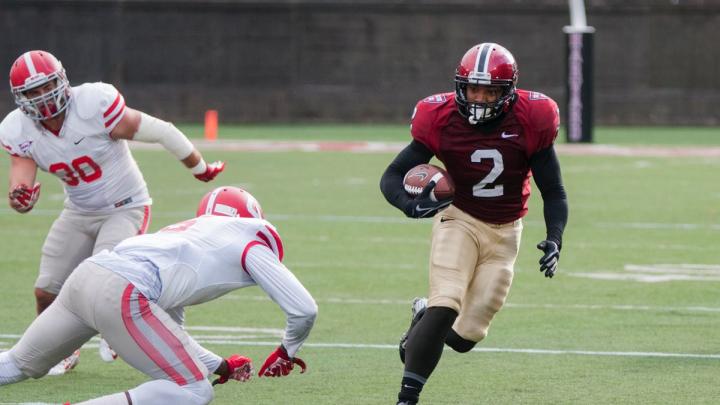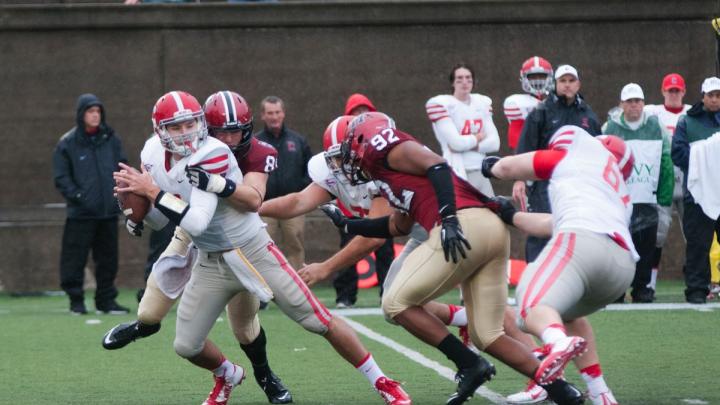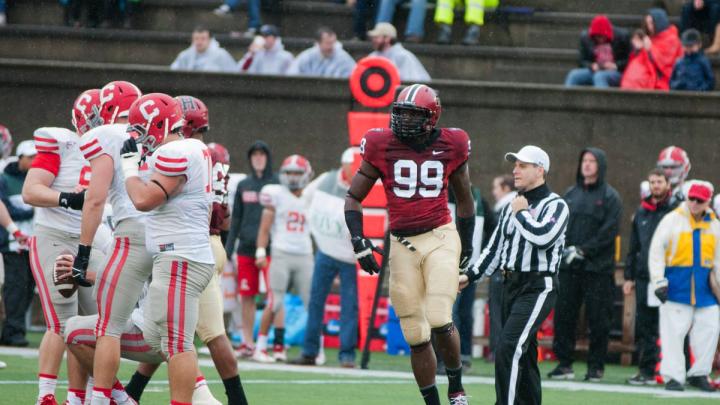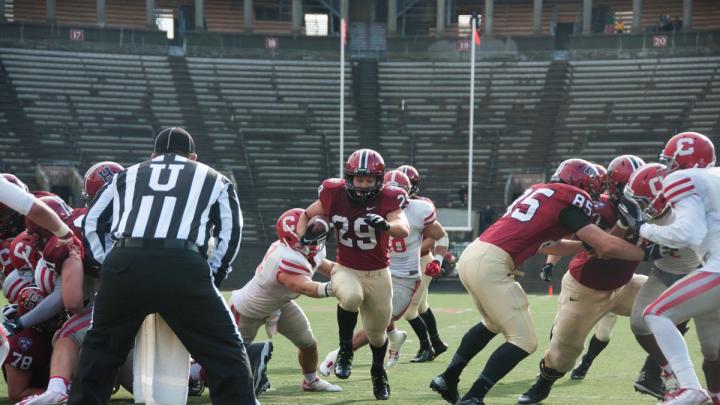It was a dark and stormy half.
The first 30 minutes of the Harvard football team’s game against Ivy League rival Cornell at the Stadium on Saturday were played in the rain and the dank. The dismal performance of the Crimson offense (and the Big Red’s, for that matter) mirrored the weather. At halftime, not a point had been scored. Then the skies cleared, Harvard’s attack got in gear, and the Crimson asserted its superiority to win 24-7. With the victory, Harvard went to 4-0 (2-0 in league play) and became (with Yale’s 38-31 loss at Dartmouth) the last unbeaten Ivy team. “It was ugly,” admitted Harvard coach Tim Murphy afterward. “We stunk the joint out at times. But it was a win.”
The first quarter wasn’t just ugly. It downright hideous. The ball was slippery and the Crimson simply could not hold onto it. The play of quarterback Scott Hosch ’16—so solid as a sub for injured first teamer Connor Hempel ’15 in wins over Holy Cross, Brown, and Georgetown—was as miserable as the weather. Hosch’s first toss was a wounded duck of a screen pass that ended up in the hands of Cornell defensive end Justin Harris—turnover number one. Later, Hosch tried to run but fumbled when he was jarred by Big Red cornerback Jarron Watson-Lewis—turnover number two. Then, on one of Hosch’s completions, tight end Jack Stansell ’18 made his second career catch but was promptly rattled by cornerback Michael Turner and coughed up the ball—turnover number three.
As the half proceeded, it became clear that every time Hosch put the ball in the air, bad things were likely to happen. Midway through the second quarter, he chucked one wildly into the left flat that was picked off by Big Red safety Rush Imhotep—turnover number four. For the half, Hosch went 8 for 20 for a mere 83 yards. The offense’s ineffectiveness and the excellent directional punting of Cornell’s Chris Fraser (who, due to the Big Red’s anemic offense, gets lots of practice) were keeping the Crimson bottled up.
Fortunately, Harvard’s defense was as magnificent as its offense was pathetic. “It was downright heroic,” said Murphy of his D. The Crimson would limit Cornell to 35 yards rushing (on 34 carries) for the game. The linebacking corps—Jacob Lindsey ’16 (12 tackles, one sack), Eric Medes ’16 (11 tackles, a sack, and an interception) and Connor Sheehan ’15 (seven tackles)—were a roving tag team that never let the Big Red up for air.
But the highlight was recorded early on, by Zack Hodges ’15. Held without a sack in the previous two games, the All-Ivy end got off the schneid before the first quarter was six minutes old, busting in unblocked on Big Red quarterback Jake Jatis. The ensuing seven-yard tackle for loss gave Hodges 21.5 sacks—breaking the Harvard career record he had shared with Chris Smith ’98. In the next quarter, Hodges would join defensive tackle Dan Moody ’16 in a sack to push his total to 22.0 and counting.
After the game, Hodges, a government concentrator from Atlanta, claimed, “I honestly didn’t know about the record until Coach told me,” and added, “I’m more proud that Jameson McShea got his first career sack,” which the junior defensive tackle managed when taking down Jatis in the second quarter. But Hodges was cognizant of history. “It’s nice to be able to put that brick in the wall that is Harvard football,” he said.
As the second half began, Murphy gave the Crimson offense a jolt by inserting running back Paul Stanton Jr. ’16. The nominal starter has been ailing (leg injury) and was held out in the first half in favor of Andrew Casten ’15. As the clouds over Soldiers Field began to part, Stanton blasted for eight yards, then 17. Hosch started finding the range as a passer, but the drive appeared to bog down when Harvard faced fourth and 14 at the Cornell 24. The conservative play would have been to settle for a 41-yard field-goal try. Murphy insisted after the game that this never entered his mind. “We were in four-down territory,” he said. Moreover, the Big Red offense was not a threat to flip the field—and Harvard place-kickers had been anything but automatic this season.
The Crimson came to the line of scrimmage. “We changed the play at the last second,” Murphy said. Hosch faded back and spied Anthony Firkser ’17 in the left corner of the end zone—all by his lonesome. Touchdown! When Andrew Flesher ’15 kicked the point after (again, hardly a fait accompli this season), it was 7-0. Afterward, Cornell coach David Archer expressed surprise over Murphy’s decision to go for it. “I thought they were going to take the points,” he said. The TD meant that Harvard hasn’t been shut out for 162 straight games—tying Brown’s Ivy record scoring streak that was halted in 2012.
For the rest of the game the Crimson mostly asserted its dominance. A 23-yard field goal by Flesher late in the third quarter made it 10-0. In the fourth quarter the offense rammed home a touchdown in only 2:05, going 60 yards in seven plays, the finale being Stanton’s four-yard touchdown bolt. (With a game total of 56 yards on only 12 carries, he had provided just the spark Harvard needed.) Harvard did commit turnover number five on a Casten fumble. (The last time the Crimson made five turnovers was on October 21, 2006, during a 41-38 loss at Princeton.) Cornell capitalized on the fumble when Jatis tossed a 26-yarder to Collin Shaw for a score. Casten subsequently atoned by finishing a six-play, 37-yard drive with a three-yard run—his eighth touchdown of the season.
The gutsy Hosch hung in there to finish with 19 of 34 passing, for 240 yards and a big touchdown. A day that had begun in the murk ended in bright autumn sunlight. The rugged portion of the Ivy schedule awaits.
Weekend Roundup
Dartmouth 38, Yale 31
Brown 27, Holy Cross 24 (2 OTs)
Colgate 31, Princeton 30
Fordham 60, Penn 22
Monmouth 61, Columbia 28
Coming up: Next Saturday, Harvard plays its final nonconference game of 2014 when it takes on Lafayette at the Stadium. Kickoff: 1 p.m. A member of the Patriot League, the Leopards are 3-3 after winning 24-21 over Georgetown last Saturday. (Harvard beat the Hoyas 34-3 on October 4.) The Crimson leads the series with Lafayette, 14-3.
When it comes to nonconference foes, Harvard leads every series except those with Geneva, Purdue, Rutgers, Stanford, and Worcester Polytechnic Institute. The Crimson is even with Buffalo, Lehigh, Michigan, and Navy. Among those who trail Harvard in head-to-head play are current college football powers Florida, Georgia, Texas, and Oregon; the Crimson beat the Ducks 7-6 in the 1920 Rose Bowl.
Of course, almost all these results are from football’s early era. Nevertheless, the next time some Big Ten rooter disparages Ivy football, tell him or her about the time 100 years ago this month that Michigan came to the Stadium and went back to Ann Arbor on the short end of a 7-0 score. Harvard was the two-time defending national champion. The game, if not The Game, was a long-awaited matchup between perennial powers of the East and West, and two of the acknowledged coaching maestros, Percy D. Haughton, A.B. 1899, and Michigan’s Fielding H. (Hurry-Up) Yost. (Today, think Alabama’s Nick Saban versus Oklahoma’s Bob Stoops.)
Perhaps the best indicator of the game’s frisson was its press coverage. Some 60 reporters were allocated space in the press stand, a very large number for a midseason game. Ring Lardner picked up the Wolverines in Ann Arbor and accompanied them on their trip east. Upon arrival, the Michigan marching band (Harvard would not have one until 1919) marched through downtown Boston blaring its fight song, “The Victors.”
The turnout was impressive, and showed the appeal and possibilities of big-time intersectional football. The attendance came to 22,297, grossing $32,831.43 at the gate. The only score came in the second quarter, on a five-yard run by Crimson All-America end-back Huntington Reed (Tack) Hardwick, A.B. 1915. Perhaps the most novel moment came between the halves when the Wolverine band paraded down on the field, “the musicians forming in a huge letter ‘M’ and tramping about in this formation,” as the Boston Globe reported. On this day, Michigan may have lost the game, but it won halftime.
Score by Quarters
Cornell 0 0 0 7 7
Harvard 0 0 10 14 24
Attendance: 9,165













